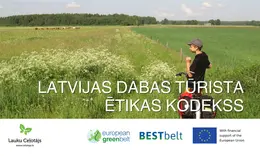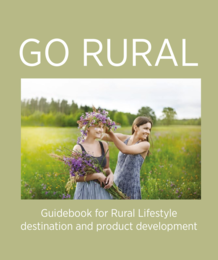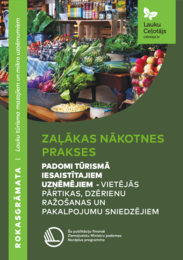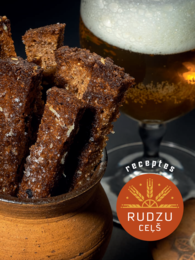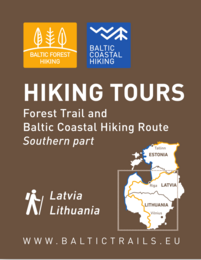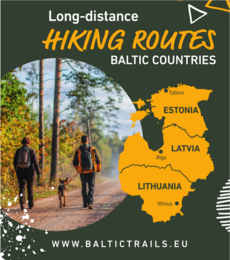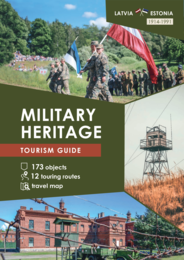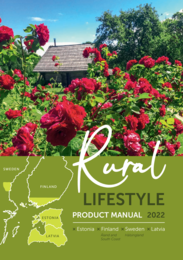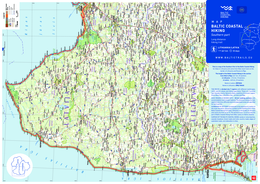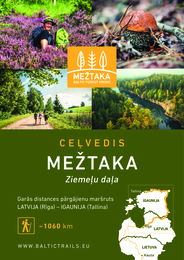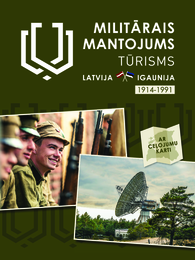Publications
Publications of "Lauku ceļotājs"
Our publications in English: accommodation catalogue „Country Holidays”, maps and travel guides for touring Latvia by car, bike, boating or hiking offer practical information and are most useful to plan and experience your holidays in Latvia. We have inspected all sites and tested all routes which are described. See below the details about contents of each of our publications.
To order the publications please send a request to the e-mail: lauku@celotajs.lv. You can pay for the publication with credit card or bank transfer. To read regular news about our new publications, please follow this link.
| Publication | Description |
|---|---|
Military Heritage travel guide (southern part)When travelling in Latvia, Estonia and Lithuania, you are invited to visit military heritage sites that trace the period from the outbreak of the First World War in 1914, the founding of the independent states of Latvia and Estonia and the restoration of independence in Lithuania after the end of the First World War in 1918, to the present day. Military heritage sites included in this guide: museums, fortresses, military equipment, trails, bunkers, battle sites, military towns, infrastructure, and memorial sites. The offer includes not only sightseeing but also guided tours, hikes to the sites of military events, meals, and other experiences. Multiple-day routes for visiting military heritage sites are recommended. The guide is accompanied by an overview map, where 242 military heritage sites in Lithuania, Latvia and Estonia are indicated, including descriptions of 113 sites in Lithuania and southern Latvia, as well as 10 touring routes. |
|
Kā top Sidrs?Real cider begins with freshly pressed apple juice — never from concentrate. Latvia’s cool northern climate and distinctive apple varieties give our ciders their signature freshness and vibrant aroma. They’re naturally higher in acidity and lighter in tannins, resulting in a crisp, bright flavour profile. While cider can be made purely from apples, it’s often infused with fruits, berries, or herbs for added character. |
|
Baltic Military Heritage Travel MapThe map features 240 military heritage sites: former military bases, coastguard structures, partisan bunkers, battle sites, museums, collections, exhibitions, monuments and memorial sites. The period of history that each site represents, as well as the title, address and contact information, are indicated. Several outdoor sites, such as battle and memorial sites and former military buildings, do not have an address or phone number which are therefore not listed. GPS coordinates have been indicated for all sites. |
|
Vadlīnijas. Militārā mantojuma izmantošana tūrismā Latvijā, Lietuvā un IgaunijāIzstrādātas vadlīnijas par to, - kā militāro mantojumu iesaistīt tūrisma produkta radīšanā, veidojot jaunus vai uzlabojot Vadlīnijas noderēs:
|
|
Latvian Nature Common Code of ConductLatvia’s forests, rivers, lakes, sea, swamps, meadows and other environmental territories are open to anyone who appreciates their content and their beauty and respects their right to exist. The Code of Conduct offers advice to travellers, observers of nature, researchers, leisure seekers, berry pickers, mushroom hunters, enjoyers of active or passive leisure, or anyone else who goes out into nature. The content of the Code is contained in five chapters:
Read Latvian Nature Common Code of Conduct online |
|
Guidebook for Rural Lifestyle destination and product developmentThis guidebook was made during a cross-border tourism initiative: Rural Lifestyle — Creating attractive rural lifestyle destinations. The main aim of the Rural Lifestyle initiative was to combine rural lifestyles and tourism products and destinations of several countries to build sufficient quality provision for foreign markets. The project developed and compiled together Rural Lifestyle |
|
Greener practices of the future in the local food and beverage production and service provider SME sectorThis manual is an online course "Greener practices of the future in local food and beverage production and service providers in the SME sector - innovative and best practice-based adult training". The manual and training course will provide the necessary background knowledge and pointers to sources of more detailed information. |
|
Recipes. Rye RoadRye bread will always have a special role on the Latvian table. It is not just a foodstuff. It is a link to our ancestors, to centuries-old traditions, beliefs, and rituals. It is the source of our strength. Rye bread is also delicious. A dark and crisp crust covers an aromatic and slightly damp interior. The bouquet of flavours is made up of rye, good water, caraway seeds, salt, sugar, and malt. Each baker has his or her own special recipe. We eat rye bread for breakfast, lunch, and dinner. It goes perfectly well with smoked pork and fish, salted herring, hemp, country butter and cottage cheese, various cheeses, vegetables, and herbs, as well as honey or jam. For celebrations, we offer rye canapés, carrot buns, and bacon buns. Nothing goes with a mug of kvass or beer better than aromatic and crispy garlic toasts. People also love desserts involving rye bread. Cakes with whipped cream and forest or garden berries, as well as a layered dessert involving rye breadcrumbs, or sweet bread soup with dried fruits and cinnamon. Wonderfully delicious and ideal for the important waste-free lifestyle of the modern age. This is a way to use bread that has dried out. Everyone will love rye gingerbread and pancakes, and that includes health nuts. A slice of pumpernickel or cake will go well with a cup of afternoon coffee. On hot summer days, we can slake our thirst with cold and foamy rye kvass. The recipes that are found here are simple. You can enjoy rye-related foods at all Latvian guesthouses and pubs. Contact them in advance to find out what’s on offer. Master classes are sometimes available where you can learn all about the secrets of rye. |
|
Hiking Tours Forest Trail And Coastal Hiking Southern partThe brochure includes 15 hiking tours for one and multiple days (up to 16 days) in Latvia and Lithuania, which are part of the Forest Trail (E11) and Baltic Coastal Hiking Route (E9) – European long distance hiking paths E11 and E9 – the most interesting, scenic forest areas of both countries, which are renowned for their natural and cultural objects. Several tours include national parks, nature parks, as well as UNESCO World Heritage sites. Every tour includes a schematic tour map, provides information about the mileage to be covered within a day, level of difficulty, most outstanding sightseeing objects, as well as practical information about the road surface, getting to the starting point. The tours are provided for both individual travellers and small tourist groups. It is recommended to book transport (rent a car or use public transportation), accommodation and meals in advance, as well as arrange personal and luggage transfer if necessary. |
|
Long Distance Hiking Routes in Baltic CountriesThe map marks and describes 10 long-distance hiking routes in the Baltic states. Each of the routes is divided into sections, so you can also do a shorter, pre-selected part of the route, depending on time and availability. |
|
Military Heritage Tourism guideWhen traveling in Estonia and Latvia, you can visit sites and objects related to military heritage history of both countries from the beginning of World War I in 1914 and the establishment of both countries’ independence in 1918, till the period of restoration of independence in 1990/1991. There are military heritage sites included in this guide such as museums, fortifications, military equipment, hiking trails, bunkers, battle sites, military towns, infrastructure and memorial sites. In addition to object visits you can experience guided tours, hikes and trips at places where military events once occurred, stories and meals at a campfire, accommodations in a partisan bunker, and other interactive experiences. Multi-day tours are recommended for exploring the military heritage sites. Serving as an overview, the map included to the guide lists the described 173 military heritage sites in Latvia and Estonia and the 12 recommended tours. |
|
Rural lifestyle product manual 2022This manual is aimed at helping travellers and tour operators discover rural destinations in Finland, Sweden, Estonia and Latvia. These Rural Lifestyle tourism products give an insight into the lives of people living in the countryside through visits to destinations outside cities and with a strong and unique identity. In this manual, each destination has a brief description followed by the programmes that can be experienced in that destination. Guests will experience life in country homesteads, farms, smallholdings and home-producers’ businesses while meeting with the local people, watching or engaging in everyday life. The visiting programmes are very varied and include: set excursion programmes, visits with guest engagement in the daily routines of country life, or leisurely stays in an authentic environment in villages or islands. Half day programmes offer brief rural experiences that can bring some diversity to existing tour operator itineraries for group and individual travel. Half day programmes can be adapted to the timings and geographical area covered by tour operators’ existing tours and fitted in as additional elements without changing the basic tour itinerary. Full day programmes and two-day programmes with overnight accommodation in country hotels or guest houses can be useful for groups and individual tourists interested in experiences outside cities. Each programme package consists of several services, usually programme visits, guide services, meals and accommodation. All of these programmes can be linked with the traditional touristic routes and city experiences to bring more variety and attraction. |
|
Map of the Southern Part of the Baltic Coastal HikingBaltic Coastal Hiking is a part of E9 long distance hiking route along the Baltic Sea coast. It starts in Nida resort town, Lithuania, near the border of Lithuania and Russia; crosses Latvia through Rīga and ends in Tallinn, Estonia. This is a map of the Southern Part of the Baltic Coastal Hiking for hikes in Lithuania and Latvia from Nida resort town on the border of Lithuania and Russia to Rīga. The route is divided into 7 regions with different landscapes, relief, natural values and hiking experience. Each region is divided into ~ 20 km long walking sections with accommodation and transport options. The distance to be performed, approximate time, difficulty level and populated areas are specified for each section. Numbering of sections corresponds to the sequence of creation of the route; therefore, sequential numbers of the Southern Part of the Baltic Coastal Hiking from Nida, Lithuania, to the border of Lithuania and Latvia are from 64 to 73. The sections from 1 to 63 include the part of Baltic Coastal Hiking from Nida, Latvia, to Tallinn, Estonia. Surface of the Baltic Coastal Hiking: sandy or rocky beaches, seaside meadows, forest roads and trails, country roads, edges of asphalted roads, and sidewalks in cities. |
|
Guide Forest trail Northern partThe guidebook introduces the northern part of the Forest Trail route from Riga to Tallinn ~ 1060 km (333 km in Latvia and 720 km in Estonia). In the guidebook the Forest Trail is divided into 8 regions – In Latvia: Riga and Riga Region, Gauja National Park, Northern Gauja Forestland, Veclaicene Forestland; In Estonia: Haanja Upland, Setomaa, Lake Peipus Shore and the North-Estonia Coastline. Each region is further divided into sections, ~ 1060 km are divided into 50 one-day sections. Each section can be done in one day, but if the kilometrage is higher, the section description provides recommendations on how to divide the section into a two-day hike.
|
|
Brochure with travel map "Military Heritage Tourism. Latvia - Estonia"When you are travelling in Latvia and Estonia, we invite you to visit sites that speak to military heritage related to the beginning of World War I in 1914, the fact that both countries won their independence in 1918, and the fact that they restored their independence in 1990/1991. Such sites include museums, fortresses, military equipment, hiking paths, bunkers, battlegrounds, military towns, infra-structure and commemorative sites. The following 150 military heritage sites are marked on the map: former military bases, coast guard structures, forest brothers’ bunkers, battlefields, museums, collections, exhibitions, monuments and memorial sites. Each site has a section with its name and a short description, address and telephone number. For many sites that can be seen in the countryside, such as battle and memorial sites, former military buildings, the address and telephone number do not exist and therefore cannot be listed. GPS coordinates are shown for all locations. Sites included in this map present the events in one or more stages of history:
The historical stages are briefly described in the brochure “Military Heritage, Latvia / Estonia 1914 – 1991”, to which this map belongs. The brochure also provides information on battle re-enactment events, military parades and national independence celebrations in Latvia and Estonia. |
|




